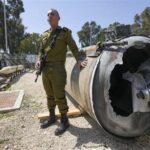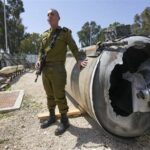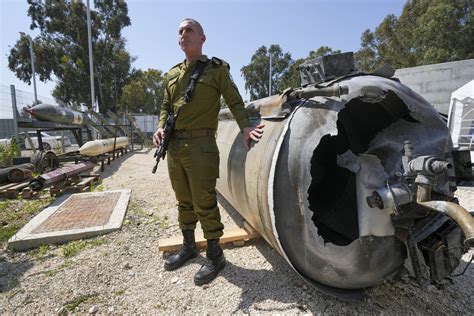
Israel’s advanced F-35I “Adir” stealth fighter jets, reportedly costing $44,000 per flight hour, have been the subject of speculation regarding potential strikes against Iranian nuclear facilities, fueled by recent aerial maneuvers and photographic evidence showcasing the aircraft’s capabilities and operational readiness. While neither Israel nor the United States has officially confirmed or denied such operations, heightened tensions in the region and ongoing concerns about Iran’s nuclear program continue to raise the specter of military intervention.
Recent photographs and reports underscore the advanced capabilities of the Israeli Air Force’s (IAF) F-35I Adir fleet, adding weight to speculation about their potential role in any future military action against Iran’s nuclear infrastructure. The F-35I, a highly customized variant of the American-made F-35 Lightning II, incorporates advanced stealth technology, sensor fusion, and electronic warfare capabilities, making it uniquely suited for penetrating heavily defended airspace like that surrounding Iranian nuclear sites. The aircraft’s purported $44,000-per-hour operating cost reflects its sophisticated technology and maintenance requirements.
The geopolitical backdrop to these developments is one of escalating tensions between Israel and Iran. Israel has long viewed Iran’s nuclear program as a grave existential threat, repeatedly stating that it will not allow Iran to develop nuclear weapons. Iran, for its part, maintains that its nuclear program is for peaceful purposes, such as energy production and medical research. However, international concerns persist due to Iran’s past nuclear activities and its continued enrichment of uranium. The collapse of the 2015 Iran nuclear deal, formally known as the Joint Comprehensive Plan of Action (JCPOA), has further exacerbated tensions, with Iran gradually rolling back its commitments under the agreement.
The potential for military conflict between Israel and Iran has been a constant concern for regional and international actors. Any such conflict would have far-reaching consequences, potentially destabilizing the entire Middle East and disrupting global energy markets. The United States, a key ally of Israel, has repeatedly stated its commitment to preventing Iran from acquiring nuclear weapons, but has also emphasized its preference for a diplomatic solution. However, the failure of diplomatic efforts to revive the JCPOA has increased the likelihood of military action.
The F-35I Adir represents a significant upgrade to the IAF’s capabilities, providing it with a stealth platform capable of operating in contested airspace. The aircraft’s advanced sensors and electronic warfare systems allow it to detect and evade enemy defenses, while its precision-guided weapons enable it to strike targets with accuracy. The IAF has invested heavily in training and integrating the F-35I into its existing fleet, conducting numerous exercises to simulate potential combat scenarios.
The recent photographs and reports highlighting the F-35I’s capabilities are likely intended to send a message to Iran, demonstrating Israel’s resolve to prevent it from acquiring nuclear weapons. They also serve to reassure Israel’s allies and deter potential adversaries. However, the use of military force against Iran’s nuclear facilities would be a high-risk undertaking, with potentially significant consequences.
The Iranian nuclear program is dispersed across multiple sites, some of which are heavily fortified and located deep underground. Any military strike would need to be carefully planned and executed to ensure its success and minimize the risk of collateral damage. Furthermore, Iran could retaliate against Israel and its allies through its network of proxies in the region, potentially escalating the conflict into a wider regional war.
Given the complexities and risks involved, Israel is likely to pursue all available diplomatic options before resorting to military force. However, the failure of diplomacy could leave Israel with no other choice but to take action to prevent Iran from acquiring nuclear weapons. The F-35I Adir would likely play a central role in any such operation, providing Israel with the stealth and firepower needed to strike Iranian nuclear facilities.
The situation remains highly volatile, and the potential for military conflict between Israel and Iran remains a significant concern. The international community continues to monitor the situation closely, urging both sides to exercise restraint and pursue a diplomatic solution. However, the window for diplomacy may be closing, and the risk of military action is growing.
Detailed Breakdown and Context:
The F-35I Adir, a cornerstone of the Israeli Air Force, stands as a testament to the nation’s commitment to maintaining a qualitative military edge in a volatile region. This advanced fighter jet, a customized variant of the Lockheed Martin F-35 Lightning II, is not merely an acquisition but a strategic asset designed to address specific security challenges faced by Israel. Its integration into the IAF’s arsenal has significantly enhanced its strike capabilities, intelligence gathering prowess, and overall operational flexibility.
The F-35I Adir: A Technological Marvel
The F-35I Adir distinguishes itself from other F-35 variants through a series of Israeli-specific modifications and enhancements. These include advanced electronic warfare systems, enhanced command and control capabilities, and the ability to carry a wider range of Israeli-developed weapons. The aircraft’s stealth technology allows it to penetrate heavily defended airspace undetected, making it ideal for missions in complex and contested environments. Its advanced sensors and data fusion capabilities provide pilots with unparalleled situational awareness, enabling them to make informed decisions in real-time. The aircraft’s high operating cost, estimated at $44,000 per flight hour, is a reflection of its technological sophistication and the intensive maintenance required to keep it operational. This cost includes fuel, maintenance, spare parts, and the highly trained personnel needed to support the aircraft.
The “Adir” (Hebrew for “mighty” or “powerful”) is equipped with a suite of advanced sensors, including the Active Electronically Scanned Array (AESA) radar, which can simultaneously track multiple targets and provide high-resolution imagery. Its Distributed Aperture System (DAS) provides 360-degree situational awareness, alerting pilots to incoming missiles and other threats. The aircraft’s electronic warfare suite can jam enemy radar and communications, disrupting their ability to track and engage the F-35I.
Strategic Implications of the F-35I Adir
The acquisition of the F-35I Adir has significantly altered the strategic landscape in the Middle East. It provides Israel with a credible deterrent against potential adversaries, signaling its willingness to defend its interests and maintain its regional dominance. The aircraft’s ability to penetrate Iranian airspace undetected has raised concerns in Tehran, forcing it to invest in advanced air defense systems to counter the threat.
The F-35I also enhances Israel’s ability to conduct long-range strike missions against targets of strategic importance, such as Iran’s nuclear facilities. While Israel has never officially confirmed its plans to attack Iran’s nuclear program, it has repeatedly stated that it will not allow Iran to acquire nuclear weapons. The F-35I provides Israel with a credible military option to prevent Iran from achieving that goal.
The Iranian Nuclear Program: A Source of Regional Instability
Iran’s nuclear program has been a source of contention for decades. While Iran insists that its nuclear program is for peaceful purposes, such as energy production and medical research, Western powers and Israel believe that Iran is secretly pursuing nuclear weapons. The 2015 Iran nuclear deal, formally known as the Joint Comprehensive Plan of Action (JCPOA), was intended to prevent Iran from developing nuclear weapons by imposing strict limits on its nuclear activities. However, the United States withdrew from the JCPOA in 2018, and Iran has since rolled back its commitments under the agreement.
The collapse of the JCPOA has led to a significant escalation of tensions between Iran and the West. Iran has increased its enrichment of uranium, raising concerns that it is moving closer to developing nuclear weapons. Israel has repeatedly warned that it will take military action if necessary to prevent Iran from acquiring nuclear weapons.
The Potential for Military Conflict
The potential for military conflict between Israel and Iran is a constant concern for regional and international actors. Any such conflict would have far-reaching consequences, potentially destabilizing the entire Middle East and disrupting global energy markets. The United States, a key ally of Israel, has repeatedly stated its commitment to preventing Iran from acquiring nuclear weapons, but has also emphasized its preference for a diplomatic solution.
However, the failure of diplomatic efforts to revive the JCPOA has increased the likelihood of military action. Israel may feel compelled to take action to prevent Iran from acquiring nuclear weapons, even without the support of the United States. The F-35I Adir would likely play a central role in any such operation, providing Israel with the stealth and firepower needed to strike Iranian nuclear facilities.
Challenges and Risks of a Military Strike
A military strike against Iran’s nuclear facilities would be a complex and risky undertaking. Iran’s nuclear program is dispersed across multiple sites, some of which are heavily fortified and located deep underground. Any military strike would need to be carefully planned and executed to ensure its success and minimize the risk of collateral damage.
Furthermore, Iran could retaliate against Israel and its allies through its network of proxies in the region, potentially escalating the conflict into a wider regional war. Iran could also launch cyberattacks against critical infrastructure in Israel and other countries.
Diplomatic Efforts and the Search for a Solution
Despite the heightened tensions, diplomatic efforts to revive the JCPOA continue. The United States and other world powers are engaged in indirect negotiations with Iran in an attempt to reach an agreement that would limit Iran’s nuclear activities in exchange for sanctions relief. However, the negotiations have been stalled for months, and it is unclear whether a deal can be reached.
Even if a deal is reached, it is unlikely to fully resolve the underlying tensions between Israel and Iran. Israel remains deeply concerned about Iran’s regional ambitions and its support for terrorist groups. The F-35I Adir will continue to play a crucial role in Israel’s defense strategy, providing it with the capability to deter Iranian aggression and protect its interests.
The Role of the United States
The United States plays a critical role in the region’s security dynamics. As Israel’s closest ally, the United States provides it with significant military and financial assistance. The United States also maintains a strong military presence in the region, which serves as a deterrent against potential adversaries.
The United States has repeatedly stated its commitment to preventing Iran from acquiring nuclear weapons. However, the United States and Israel have different views on how best to achieve that goal. The United States prefers a diplomatic solution, while Israel is more willing to consider military action.
The United States has also expressed concerns about the potential consequences of a military strike against Iran’s nuclear facilities. A military conflict could destabilize the region, disrupt global energy markets, and draw the United States into another costly war.
Conclusion: A Precarious Balance
The situation in the Middle East remains highly volatile, and the potential for military conflict between Israel and Iran remains a significant concern. The F-35I Adir represents a significant upgrade to the IAF’s capabilities, providing it with a stealth platform capable of operating in contested airspace. However, the use of military force against Iran’s nuclear facilities would be a high-risk undertaking, with potentially significant consequences.
The international community continues to monitor the situation closely, urging both sides to exercise restraint and pursue a diplomatic solution. However, the window for diplomacy may be closing, and the risk of military action is growing. The future of the region depends on the choices that Israel, Iran, and the United States make in the coming months. The balance of power remains precarious, with the F-35I Adir a key element in Israel’s defense posture, but not a guarantee of stability in a highly complex and unpredictable environment. The operational cost of these aircraft, the political will to use them, and the potential ramifications of their deployment all contribute to a tense and uncertain future.
Expanded Analysis:
The narrative surrounding Israel’s F-35I “Adir” and its potential deployment against Iranian nuclear sites is layered with strategic considerations, technological capabilities, and geopolitical complexities. To fully understand the implications, it is crucial to delve deeper into these elements.
The F-35I Adir: A Deeper Dive into Capabilities
Beyond the general description of stealth and sensor fusion, the F-35I “Adir” boasts several critical capabilities that make it uniquely suited for a potential strike against Iran:
- Penetration of Advanced Air Defense Systems: Iran has invested heavily in its air defense network, including Russian-made S-300 systems. The F-35I’s stealth technology is designed to minimize its radar cross-section, making it extremely difficult for these systems to detect and track. The aircraft also possesses electronic warfare capabilities to further disrupt and jam enemy radar, increasing its chances of successfully penetrating Iranian airspace.
- Precision Strike Capability: The F-35I can carry a variety of precision-guided munitions, allowing it to accurately target specific facilities within Iran’s nuclear infrastructure. This is crucial for minimizing collateral damage and ensuring the effectiveness of any strike. The aircraft’s advanced targeting systems and sensor fusion capabilities enable it to identify and engage targets even in complex and cluttered environments.
- Intelligence Gathering and Surveillance: The F-35I’s advanced sensors can be used to gather intelligence and monitor Iranian nuclear sites. The aircraft can collect high-resolution imagery and electronic intelligence, providing valuable information for mission planning and targeting.
- Network-Centric Warfare: The F-35I is designed to operate as part of a network-centric warfare environment, sharing data with other aircraft, ground stations, and naval vessels. This allows for improved situational awareness and coordination, enhancing the effectiveness of any military operation.
- Long-Range Strike Capability: While the F-35I has a limited internal fuel capacity, it can be equipped with external fuel tanks to extend its range, allowing it to reach targets deep within Iran. Air-to-air refueling capabilities further enhance its reach and loiter time.
Iran’s Nuclear Program: A Detailed Overview of the Challenge
Understanding the Iranian nuclear program is essential for assessing the potential impact of any military strike. Key aspects include:
- Dispersed and Fortified Sites: Iran’s nuclear facilities are dispersed across multiple locations, some of which are heavily fortified and located deep underground. This makes them difficult to target and destroy. Key sites include Natanz, Fordow, and Arak.
- Enrichment Capabilities: Iran has the capability to enrich uranium to various levels, including weapons-grade. The higher the level of enrichment, the closer Iran is to developing a nuclear weapon.
- Research and Development: Iran is actively engaged in research and development activities related to nuclear weapons, even if it is not currently building a bomb. This includes work on warhead design, missile delivery systems, and other related technologies.
- Dual-Use Technology: Many of the technologies used in Iran’s nuclear program have dual-use applications, meaning they can be used for both peaceful and military purposes. This makes it difficult to distinguish between legitimate activities and those related to weapons development.
- International Monitoring: The International Atomic Energy Agency (IAEA) is responsible for monitoring Iran’s nuclear program to ensure that it is not being used for military purposes. However, the IAEA’s access to Iranian facilities has been limited in recent years, raising concerns about transparency.
The Potential Consequences of a Military Strike:
The consequences of a military strike against Iran’s nuclear facilities would be far-reaching and potentially catastrophic:
- Escalation of Conflict: A military strike could trigger a wider regional conflict, drawing in other countries such as Hezbollah, Syria, and potentially even Russia.
- Iranian Retaliation: Iran could retaliate against Israel and its allies through its network of proxies in the region, launching missile attacks, cyberattacks, and terrorist attacks.
- Disruption of Global Energy Markets: The conflict could disrupt oil production and shipping in the Persian Gulf, leading to a surge in global oil prices and potentially triggering a global recession.
- Humanitarian Crisis: A military conflict could result in a humanitarian crisis, with large-scale displacement of civilians and widespread suffering.
- Nuclear Proliferation: A military strike could embolden other countries in the region to pursue nuclear weapons, further destabilizing the region.
- Environmental Damage: Strikes against nuclear facilities could release radioactive materials into the environment, causing long-term health and environmental damage.
Alternative Strategies and Diplomatic Solutions:
Given the risks and potential consequences of a military strike, alternative strategies and diplomatic solutions should be pursued:
- Renewed Diplomatic Efforts: Efforts to revive the JCPOA should be intensified, with the aim of reaching an agreement that would limit Iran’s nuclear activities in exchange for sanctions relief.
- Strengthening International Monitoring: The IAEA’s monitoring capabilities should be strengthened to ensure that it has access to all Iranian nuclear facilities and can verify that Iran is not pursuing nuclear weapons.
- Deterrence and Containment: A strategy of deterrence and containment should be pursued, aimed at deterring Iran from acquiring nuclear weapons and containing its regional ambitions.
- Support for Iranian Dissidents: Support should be provided to Iranian dissidents who are working to promote democracy and human rights in Iran.
- Regional Security Cooperation: Efforts should be made to promote regional security cooperation, with the aim of reducing tensions and preventing conflict.
The F-35I Adir in the Broader Context:
The F-35I Adir is not merely a weapon system; it is a symbol of Israel’s commitment to its security and its determination to maintain its qualitative military edge. Its presence in the IAF’s arsenal sends a clear message to Iran and other potential adversaries that Israel is prepared to defend its interests. However, the F-35I is not a silver bullet, and it cannot solve all of Israel’s security challenges. A comprehensive approach that combines military strength with diplomacy, deterrence, and regional cooperation is needed to ensure Israel’s long-term security.
The debate surrounding the F-35I and its potential use against Iranian nuclear sites highlights the complex and dangerous dynamics of the Middle East. The stakes are high, and the decisions that are made in the coming months will have far-reaching consequences. A careful and nuanced approach is needed to navigate this challenging situation and prevent a catastrophic conflict.
Frequently Asked Questions (FAQ):
-
What is the F-35I “Adir” and what makes it special?
- The F-35I “Adir” is a highly advanced, fifth-generation stealth fighter jet customized for the Israeli Air Force (IAF). It’s a variant of the American F-35 Lightning II, but with unique Israeli-developed electronic warfare systems, command and control capabilities, and the ability to carry a broader range of Israeli-made weaponry. Its stealth technology allows it to penetrate heavily defended airspace, and its advanced sensors provide unparalleled situational awareness.
-
Why is there speculation about Israel using the F-35I to strike Iran’s nuclear facilities?
- Israel views Iran’s nuclear program as an existential threat and has repeatedly stated it will not allow Iran to develop nuclear weapons. The F-35I’s capabilities make it uniquely suited for such a mission, as it can evade Iranian air defenses and deliver precision strikes. Heightened tensions, the collapse of the JCPOA, and recent exercises showcasing the F-35I’s readiness have fueled speculation.
-
How much does it cost to operate the F-35I per flight hour, and why is it so expensive?
- Reports indicate the F-35I costs approximately $44,000 per flight hour. This high cost is due to its sophisticated technology, complex maintenance requirements, specialized spare parts, and the need for highly trained personnel to operate and maintain the aircraft. The advanced stealth coatings and electronic systems also contribute significantly to the operating costs.
-
What are the potential consequences of a military strike on Iran’s nuclear facilities?
- A military strike could lead to a wider regional conflict, involving Iran’s proxies like Hezbollah, and potentially drawing in other nations. Iran could retaliate with missile attacks, cyber warfare, and terrorist actions. It could also disrupt global oil supplies, leading to economic instability. Furthermore, there’s the risk of environmental damage from strikes on nuclear sites and the potential for nuclear proliferation if other nations in the region decide to pursue nuclear weapons.
-
Are there any alternatives to military action against Iran’s nuclear program?
- Yes, several alternatives exist. These include renewed diplomatic efforts to revive the JCPOA, strengthening international monitoring of Iran’s nuclear activities by the IAEA, pursuing a strategy of deterrence and containment, supporting Iranian dissidents, and fostering regional security cooperation to reduce tensions and prevent conflict. The US prefers a diplomatic solution, while Israel is more open to military action.









